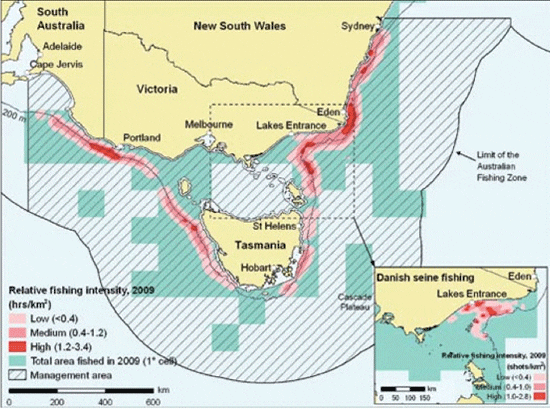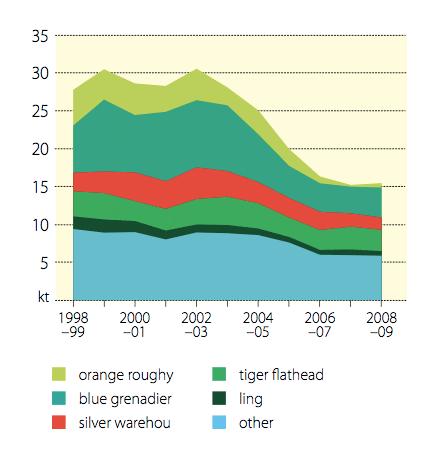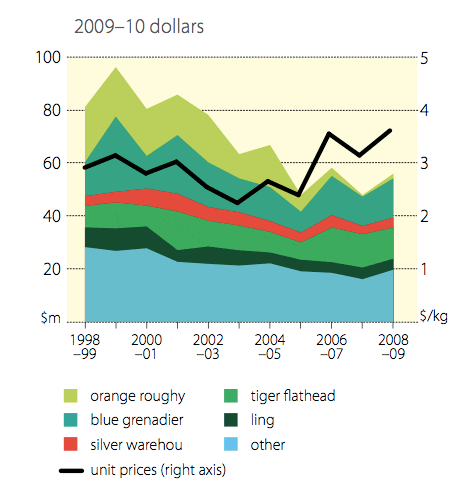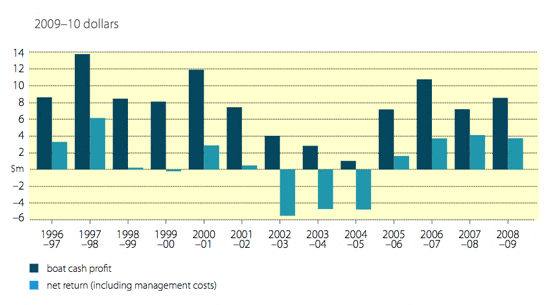Previously managed as the South East Trawl Fishery, the sector is one of Australia’s oldest commercial fishing sectors, commencing operation off the coast of Sydney in the early 1900s (DEH 2003). Activity in the CTS occurs in waters extending south from Barrenjoey Point (north of Sydney) around the New South Wales, Victorian and Tasmanian coastlines to Cape Jervis in South Australia (map 2). The primary harvesting method used in the sector is otter trawling, although a number of Danish seine boats operate out of Lakes Entrance in Victoria.
Location and relative fishing intensity, Commonwealth Trawl Sector, 2009

Management of the fishery is mainly based on output controls in the form of individual transferable quotas and total allowable catches (TACs) on key species. Under this system, there are 16 individual quota species and 29 species that are covered under basket or multispecies quotas (Stobutzki 2010). However, more than 100 species are routinely caught in the CTS. Since 2005, a harvest strategy framework has been used as a guide when determining TACs to provide a more strategic approach. The framework uses TACs to manage fisheries at target biomass levels. The rules that guide TAC setting have been designed to incorporate more precaution when there is increased uncertainty about stock status. The framework also improves the transparency of the TAC setting process (Larcombe and McLoughlin 2007). In November 2005, the Australian Government announced the $220 million Securing Our Fishing Future initiative. The initiative aimed to reduce excess effort in fisheries subject to overfishing or at significant risk of overfishing. As part of the initiative, $149 million was set aside for a voluntary tender process for fishing businesses to exit the industry (DAFF 2006). At the completion of the buyback in November 2006, a total of 59 CTS boat statutory fishing rights had been bought out (Vieira et al. 2010). For more information about the CTS, and SESSF more broadly, see Wilson et al. 2010.
Catch and gross value of production
Catches in the CTS peaked at 30 600 tonnes in 2002–03, when catches of orange roughy and blue grenadier were substantially higher than more recent catches (figure e). In the period that followed 2002–03, catches declined each year up to and including 2007–08. In 2008–09, catches increased slightly by 2 per cent to 15 400 tonnes.
This is approximately half the 2002–03 peak catch and reflects more conservative TAC settings and lower boat numbers. Three key species—blue grenadier (4000 tonnes), tiger flathead (2800 tonnes) and silver warehou (1600 tonnes)—constituted more than 54 per cent of the 2008–09 catch.
Historically, the sector’s gross value of production (GVP) has followed a similar downward trend to catches (figure f). In 1999–2000, GVP in real terms was $98.4 million (2009–10 dollars). The value of the sector in 2008–09 was $57.2 million, which was 42 per cent lower than in 1999–2000. However, if it were not for large increases in the average unit price received for catches in recent years, it is likely GVP would be even lower. Average real unit prices were $2.46 a kilogram in 2005–06, but have increased by 51 per cent to $3.71 a kilogram since then. This has been driven mainly by increased prices for blue grenadier and tiger flathead. At the species level, the reduction in the value of orange roughy production from $21.3 million in 1998–99 to $1.8 million in 2008–09 has been a key change and is the result of stock declines and large TAC reductions for this species.
Landed catch, Commonwealth Trawl Sector

Real gross value of production and unit prices, Commonwealth Trawl Sector

Survey results
Boats surveyedThe current survey of the CTS covered the 2007–08 and 2008–09 financial years. The survey method used by ABARES is described in appendix B. The target population for the survey was defined as boats that operated in the sector and caught more than 1000 kilograms in either of two financial years, with the exception of two factory trawlers that were excluded from the analysis. Aside from difficulties in sampling these factory trawl operators, these boats are excluded because they have revenue and cost structures that are unrepresentative of the population.
Within the defined population, boats can be divided into two categories: otter trawlers and Danish seiners. In both 2007–08 and 2008–09, 7 Danish seine boats were sampled out of a population of 13. For otter trawler boats, 7 out of 37 boats were sampled in 2007–08 and 8 out of 39 boats were sampled in 2008–09.
Survey-based estimates of average boat-level financial performance are presented in nominal terms in table 5. Definitions of items included in table 5 are provided in appendix A. Financial performance estimates include the receipts and costs earned and incurred by boats in both the sector being surveyed and any other fisheries that sampled boats may have operated in during the survey years. In the case of the CTS, none of the boats sampled in the 2010 survey operated in other fisheries. As such, the financial performance measures presented in this year’s report in table 5 relate only to the CTS. The results reported in table 5 are divided into ‘trawl’, ‘Danish seine’ and ‘all boats’. The species targeted and cost and revenue structures associated with the trawl and Danish seine methods differ. As a result, it is necessary to stratify the survey population by method in order to derive these survey-based estimates. This ensures that sampled boats only represent those non-sampled boats that used the same method and, therefore, were likely to have the same cost and revenue structure.
ReceiptsAverage seafood receipts per boat in the CTS decreased by 4 per cent between 2007–08 and 2008–09 from $1 020 000 to $982 000 (nominal terms). Seafood receipts are substantially greater for the average trawl boat compared with Danish seine boats. The average trawl boat reported a slightly greater decrease in seafood receipts between 2007–08 and 2008–09, from $1 154 000 in 2007–08 to just over $1 098 000 in 2008–09. Seafood receipts for the average Danish seine boat remained relatively constant, falling by 1 per cent to $633 000 in 2008–09. Average seafood receipts reported by the average CTS boat in 2007–08 were 43 per cent higher than those reported for the 2006–07 financial year (Vieira et al. 2008).
CostsTotal cash costs for the average boat in the CTS also decreased in nominal terms in 2008–09, but by an amount similar to seafood receipts. Total cash costs were $941 000 a boat in 2007–08 and decreased by 5 per cent to $895 000 a boat in 2008–09. The key cost items in both years were crew costs (accounting for 31 per cent of total cash costs in 2008–09), fuel (23 per cent), freight and marketing (16 per cent) and repairs and maintenance (10 per cent). Together, these cost items accounted for 80 per cent of total cash costs for the average CTS boat. Key changes between 2007–08 and 2008–09 were a 9 per cent decline in average fuel cost per boat and a 9 per cent decline in average freight and marketing costs. The decrease in average fuel costs may have resulted from a combination of lower average effort levels and the fall in average fuel prices between the two years. The decrease in freight and marketing costs is broadly consistent with the decreases in fish sales. Total cash costs per trawl boat were higher relative to the average Danish seine boat. Total cash costs were $1 098 000 per trawl boat in 2007–08 and decreased by 7 per cent to $1 023 000 per trawl boat in 2008–09. The average Danish seine boat reported an increase in total cash costs of 3 per cent between 2007–08 and 2008–09, with 82 per cent of the total in 2008–09 comprising crew costs, fuel, freight, marketing, and repairs and maintenance. Total cash costs for the average Danish seine boat increased from $497 000 to $513 000 over the two-year survey period. Fuel, labour, and repairs and maintenance costs are substantially lower for the average Danish seine boat than for the average trawl boat. In particular, fuel costs for the average Danish seine boat were $42 000 in 2008–09 compared with $264 000 for the average trawl boat.
Since trawl boats comprise a larger proportion of the fleet than Danish seine boats, the 7 per cent decrease in total cash costs for the average trawl boat has outweighed the 3 per cent increase in total cash costs for the average Danish seine boat, resulting in a decrease in total cash costs of 5 per cent for all boats.
Boat cash income reflects the difference between total cash receipts and total cash costs per boat. For the average boat in the CTS, boat cash income increased from $148 000 a boat to $186 000 a boat between 2007–08 and 2008–09, which was an increase of 26 per cent (nominal terms). This compares with a 43 per cent increase for the average trawl boat, from $140 000 a boat to $201 000 a boat, and a 16 per cent decrease for the average Danish seine boat, from $168 000 a boat to $141 000 a boat over the two-year period. Boat business profit, which is boat cash income less depreciation, for the average CTS boat improved from $125 000 a boat in 2007–08 to $157 000 a boat in 2008–09. For trawl boats, boat business profit improved by 46 per cent in 2008–09 to $171 000 a boat. The average Danish seine boat is estimated to have reported a 20 per cent decrease in boat business profit. Profit at full equity, which is boat business profit plus interest, leasing and rent, increased by 37 per cent to $220 000 a boat between 2006–07 and 2007–08 when compared with previous survey results for the fishery (Vieira et al. 2008). It then increased further to $242 000 a boat in 2008–09. This profit measure is calculated by removing all costs associated with interest, leasing and rent to treat these items as transfers to other entities rather than costs. While these items impose a cost on the operator, they represent profits that have been redistributed to other investors in the fishery. As such, profit at full equity represents the average return to the business unit had the boat and capital (including quota and licences) been fully owned by the operator. Profit at full equity was relatively higher in both years for trawl-based boats, and increased from $231 000 a boat in 2007–08 to $277 000 a boat in 2008–09. However, the average profit at full equity for Danish seine boats fell over the same period, from $188 000 to $138 000.
Rates of returnThe rate of return to boat capital, excluding the value of quota and licences, for the average CTS boat fell slightly between survey years, from 57 per cent a boat in 2007–08 to 54 per cent a boat in 2008–09. This latter value compares with returns to boat capital of 56 per cent and 44 per cent for the average trawl boat and the average Danish seine boat, respectively, in 2008–09. To allow the financial performance of all boats to be compared irrespective of the operators’ equity in the business unit, rates of return are calculated assuming all capital assets are owned by the operator.
The rate of return to full equity includes the value of quota and licences in addition to other capital, and therefore provides an indication of the return to total capital invested in the business unit. It reflects changes in the value of capital, quota and licences, as well as changes in boat-level profitability. The rate of return to full equity for the average boat in the CTS remained relatively constant, falling from 11 per cent a boat in 2007–08 to 10 per cent in 2008–09. The average trawl boat benefited from an increase in its rate of return to full equity, from 11 per cent to 12 per cent. The average Danish seine boat incurred a decrease in this profit measure from 9 per cent to 6 per cent over the two-year survey period.
Sector-level economic performance
The boat-level estimates displayed in table 5 indicate the financial performance of the average boat in the CTS in 2007–08 and 2008–09. However, the measure presented is generally not an accurate indicator of sector level economic performance as it excludes some key economic costs. Table 6 contains historical receipts, costs and key measures of sector level profitability; namely, boat cash profit and net economic return, in real terms. Boat cash profit measures the difference between cash receipts and cash costs in a sector. As such, it reveals the cash position of the sector. Net economic return, in comparison, reveals economic profitability, as it incorporates depreciation costs and the opportunity cost of capital and labour and it treats all interest and leasing expenditure as an economic return to external investors in the sector. Furthermore, it includes the total amount spent on managing the sector, rather than just the management fees recovered from operators. A more detailed explanation of net economic return is included in appendix A. In real terms, fishing income has declined since 2000–01, when it was $87.6 million (2009–10 dollars). This has reflected falls in total landings, resulting from declines in stocks of key species, reductions in TACs and a fall in the number of boats operating in the sector. Since 2004–05, the declines in fishing income have slowed to average 1 per cent a year over the four years, to slightly more than $50 million in 2008–09.
Operating costs have also declined in real terms since peaking at $77.8 million in 2001–02, subsequently falling to $41.8 million in 2008–09. This decline has occurred faster than the fall in fishing income in recent years. While income has fallen by 2 per cent a year since 2004–05, costs have fallen by an average of 5 per cent a year. As a result, boat cash profit, which had initially declined from $11.9 million in 2000–01 to a low of 1.0 million in 2004–05, has recovered to $8.6 million in 2008–09 (figure g). With the inclusion of economic costs and the removal of interest, leasing and management fees (see appendix A for explanation), net economic returns (excluding management costs) have also recovered strongly since 2004–05. This improvement has been driven by the increase in boat cash profit, which may be the result of the decline in boat numbers and, consequently, costs.
Real net economic returns (excluding management costs) increased from –$1.1 million in 2004–05 to $7.5 million in 2008–09. This figure is 4 per cent lower than the $7.8 million reported in 2006–07. When management costs are included, it is estimated that net economic returns have improved from –$4.8 million in 2004–05 to $3.9 million in 2008–09. Factors outside the control of fishery management affect both net economic returns and other measures of financial performance in the sector. For example, movements of the Australian dollar affect the prices received by fishers as well as the prices of some fishery inputs, such as fuel. More generally, the price of inputs such as fuel and gear are not controlled by fishery managers. However, the fishery manager can alter management settings to ensure net economic returns can be maximised given prevailing input and output prices. This may require periodic review of the optimal level of catch and effort in the fishery to ensure stocks are maintained at profitable levels.
Boat cash profit and net economic returns, total for the Commonwealth Trawl Sector

Preliminary estimates of economic performance
Non-survey–based estimates of real net economic returns for 2009–10 are presented in table 7, together with survey-based estimates for 2008–09 for comparison. The break-up of revenues and costs in table 7 differs to that in table 6 because of the different approaches taken to estimating the individual cost components in each table. Summary statistics for the 2009–10 preliminary estimates for the CTS are provided in appendix D. The approach taken to estimating 2009–10 non-survey–based estimates for the CTS is presented in appendix C. At the sector level, real cash receipts are expected to have remained relatively constant between 2008–09 and 2009–10, declining by 4 per cent to $48.3 million (2009–10 dollars). A 9 per cent decline in catch and a 9 per cent increase in gross value unit prices in 2009–10 are the basis for this relative stability (table 8). Total adjusted operating costs are expected to have declined by $4.9 million (12 per cent), from $40.6 million in 2008–09 to $35.7 million in 2009–10. The main driver of this was a $2.5 million (24 per cent) fall in fuel costs between 2008–09 and 2009–10 to $7.9 million. This estimate is based on declines in average effort per boat in 2009–10, a 12 per cent decline in the price of fuel and a fall in the number of boats in the sector’s surveyed population, from 52 boats in 2008–09 to 49 boats in 2009–10. Other key cost changes between 2008–09 and 2009–10 were a $1.4 million (14 per cent) decline in other service costs and a $0.9 million (21 per cent) decline in repairs and maintenance costs.
With the deduction of capital costs, which are expected to decline slightly between 2008–09 and 2009–10, net economic returns (excluding management costs) are expected to increase from $7.2 million in 2008–09 to $10.3 million in 2009–10. With the inclusion of management costs, net economic returns are estimated to have increased by 73 per cent between 2008–09 and 2009–10, from $3.7 million to $6.8 million. Net economic returns in the sector have been positive since 2005–06 (figure h). The fall in boat numbers between the two years means that the improvement in net economic returns at the boat level is more substantial than at the fishery level. Net economic returns (including management costs) increased from $76 000 a boat in 2008–09 to $139 000 a boat in 2009–10. More detail on the drivers of changes in historical economic performance in this sector is provided in Wilson et al. 2010.

